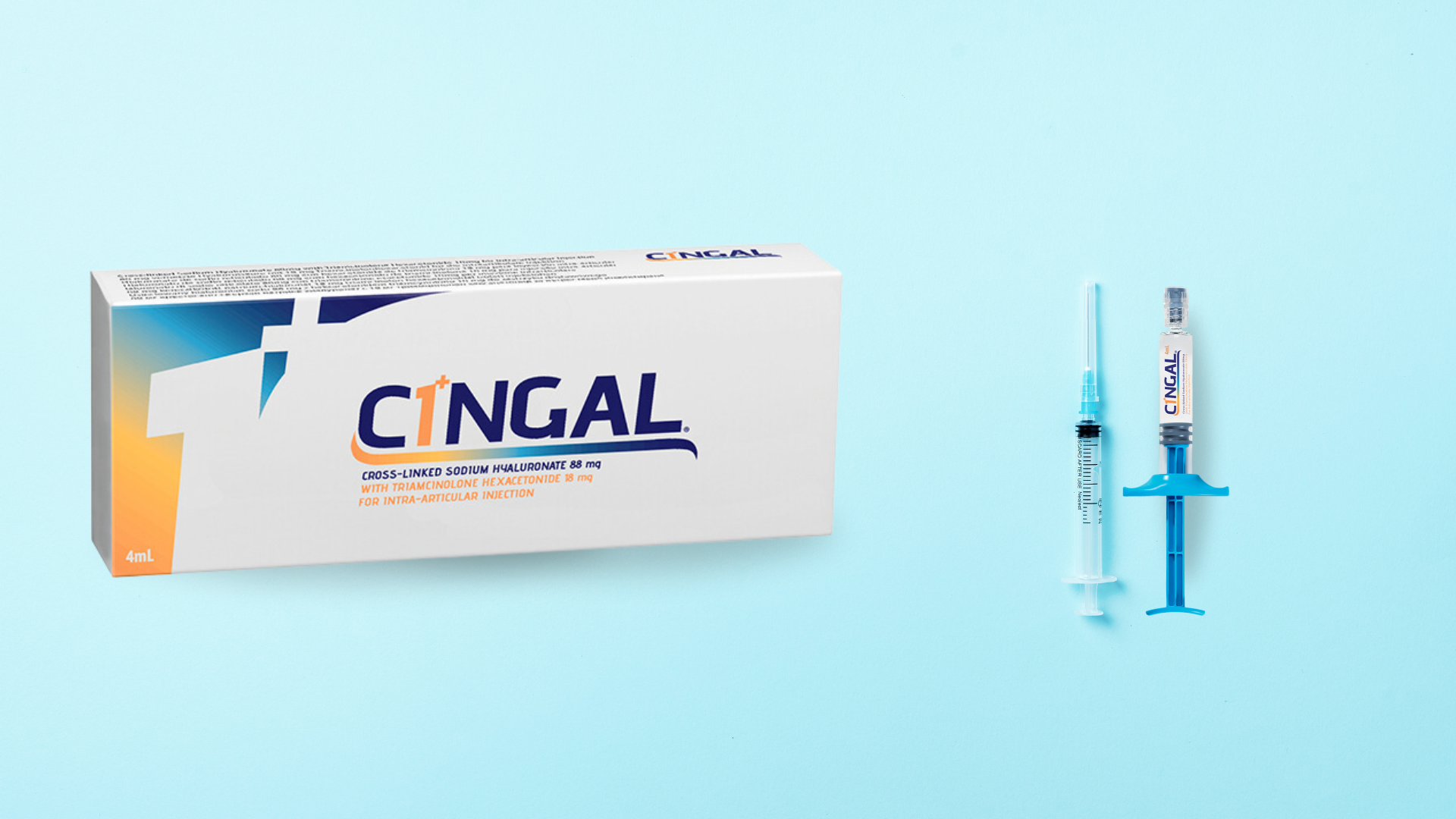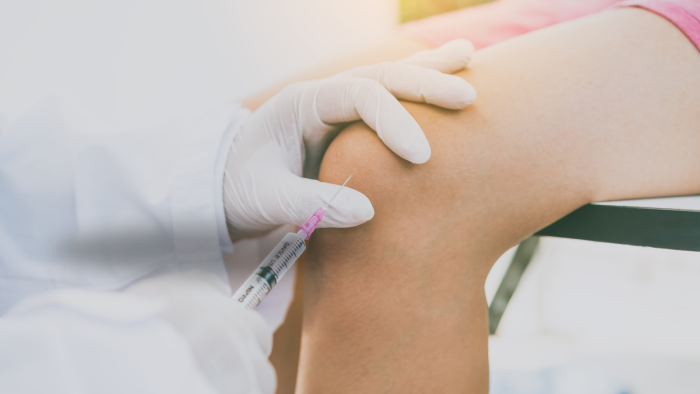SHARE THIS ARTICLE

Cingal
Understanding the Differences: Cingal vs. Cortisone Injections
Feb 20, 2024
According to the latest data from the World Health Organization, around half a billion people worldwide suffer from osteoarthritis (OA). Out of all the joints that can be afflicted, this degenerative disease affects the knee joints the most. Knee OA can significantly impact a person’s quality of life and how they can perform basic movements, such as walking or sitting down.
Recent developments in orthopedic medicine have become a go-to treatment for individuals battling osteoarthritis (OA) in the knee and other joints. Nowadays, doctors use Cingal or cortisone injections to help relieve any joint pain their patients experience. However, what is the difference between these two injectables?
This article aims to distinguish the differences between Cingal and cortisone injections, exploring how they’re administered and the therapeutic benefits each injection can bring.
Key Takeaways
- Cingal shots are unique because they mix hyaluronic acid and steroids. This helps with knee pain by fighting inflammation and making your joints move better. They work well for a long time, up to six months.
- Cortisone injections are good at quickly reducing swelling and discomfort in various body parts, but they might not help as long as Cingal does. These injections mainly focus on calming inflammation.
- Choosing between Cingal vs cortisone depends on what you need. Think about whether you want fast relief or something that lasts longer. Also, consider how bad your pain is and if there are any side effects.
Introduction to Orthopedic Injections

Orthopedic injections are crucial in managing joint-related conditions, providing targeted relief from pain and inflammation. These injections are designed to deliver therapeutic agents directly into the affected joint, offering a non-invasive treatment option for individuals with orthopedic issues.
These shots help people with pain in places like their knees or hips. Understanding the differences between various orthopedic injections is essential for patients, caregivers, and healthcare practitioners to make informed decisions about the most suitable treatment options.
Each one works best for specific problems. For example, cortisone shots offer fast relief by lowering swelling. On the other hand, Cingal injection for knee pain mixes cortisone and hyaluronic acid to give quick relief and long-lasting lubrication to the joint.
Overview of Cingal and Cortisone Injections
Osteoarthritis (OA) is a common joint condition distinguished by the deterioration of cartilage, leading to pain and stiffness in the affected joint. The knee joint is a frequent target of OA, causing significant discomfort and impacting daily activities.
Cingal and cortisone injections represent two treatment options for managing knee OA symptoms. While both offer pain relief, they differ in their composition and mechanism of action.
Cingal hyaluronic acid injections offer a blend of hyaluronic acid and corticosteroid, targeting knee joint pain relief. They shine as a single-injection treatment for osteoarthritis (OA) knee discomfort, promising up to six months of ease. This dual-action formula not only soothes the area but also lubricates the joint, making it a standout option for those seeking lasting relief without frequent visits to their doctor.
On the other hand, cortisone shots focus on reducing pain, swelling, and irritation swiftly in various body parts. While they might not have the extended duration of action like Cingal, they are well-regarded for their quick effectiveness.
Purpose of These Injections in Orthopedic Care
Orthopedic care often uses injections to help people with knee osteoarthritis. For those dealing with mild to moderate pain, treatments like Cingal and cortisone injections are life-changers. They target the pain and swelling directly in the knee. This means patients can move better and feel less discomfort.
The main goal behind using Cingal or cortisone is to improve quality of life. People don’t just find relief from ongoing knee pain; they also enjoy a more active lifestyle without surgery’s risks or downtime. Both options offer a way to manage symptoms effectively, but each works differently inside the body to achieve this result.
Composition and Mechanism of Action

Composition of Cingal Injections
What is Cingal injection made of? These innovative shots offer a unique combination of two active ingredients to address knee osteoarthritis (OA) symptoms:
- Hyaluronic acid (HA): This naturally occurring sugar molecule is crucial to healthy synovial fluid, the lubricant within your joints. HA plays a vital role by creating a smooth surface for reduced friction, absorbing shock to protect cartilage, and even supporting the production of other lubricants necessary for joint health.
- Corticosteroid (Triamcinolone Hexacetonide): This potent anti-inflammatory medication suppresses inflammation and modulates the immune system’s response in the affected joint. This translates to a reduction in swelling, pain, and stiffness, providing much-needed relief.
Cingal’s distinct composition allows it to tackle OA from two angles: immediate pain relief through the corticosteroid and long-term lubrication and joint support through the HA. This unique combination aims to improve your present discomfort and joint health in the future.
Composition of Cortisone Injections
Unlike Cingal, cortisone injections solely rely on a single active ingredient: a corticosteroid medication. This medication, often cortisone acetate or triamcinolone acetonide, is designed to combat inflammation.
Its primary function is to target specific molecules and pathways involved in the inflammatory response within the joint. By doing so, it aims to:
- Suppress inflammation: This translates to a reduction in swelling, pain, and stiffness, offering relief from the discomfort associated with knee osteoarthritis (OA).
- Modulate the immune system: Cortisone injections calm the body’s inflammatory response in the affected joint, creating a more favorable environment for healing and pain reduction.
While the benefits of cortisone injections are undeniable, it’s important to remember that they primarily focus on addressing the immediate symptoms of OA, offering pain relief that typically lasts for weeks or months. They do not provide the long-term joint support and lubrication offered by Cingal injections containing hyaluronic acid.
Mechanism of Action for Cingal Injections
Cingal injections combine the benefits of hyaluronic acid, known for its lubricating and cushioning properties, with the anti-inflammatory effects of the steroid component. This dual action aims to reduce pain, improve joint function, and address the underlying inflammation associated with osteoarthritis.
Mechanism of Action for Cortisone Injections
Cortisone injections, on the other hand, solely rely on the anti-inflammatory properties of corticosteroids to alleviate pain and swelling in the affected joint. These injections work by suppressing the immune response and reducing the production of inflammatory substances within the joint.
Modes of Administration for Cingal and Cortisone Injections
Both Cingal and cortisone injections are administered through a similar process, following these key steps:
- Pre-injection Consultation: A healthcare professional will thoroughly evaluate your medical history, symptoms, and suitability for the injection. They will also discuss the potential benefits and risks of the procedure and answer any questions you may have.
- Preparation: If your doctor clears you to receive either Cingal or cortisone injections, they will start preparing you for the procedure. What usually happens during this time is they clean and sterilize the injection site to minimize the risk of infection.
- Injection: Once you’re ready to receive the injection, the practitioner will use a thin needle to inject the medication right into the affected joint space.
Cingal and cortisone shots are typically administered as single injections. However, repeat injections may be recommended depending on your individual needs and the specific treatment plan given to you by your doctor.
Additionally, cortisone shots can be given in different ways – not just in the knee but also by mouth or even into a vein (on special occasions). This flexibility means doctors must pick how best to give cortisone based on each person’s needs.
By understanding the shared and distinct characteristics of Cingal and cortisone injections, along with the standard administration process, individuals can make informed decisions about their treatment options for managing knee OA.
Therapeutic Benefits and Efficacy
For Cingal hyaluronic acid injections, its corticosteroid component quickly acts so inflammation goes down and patients achieve relief from pain and stiffness in their joints. Moreover, the hyaluronic acid component works gradually over time, replenishing lost synovial fluid to heal the joints and improve their function and mobility.
Studies have also shown that Cingal injections can provide significant and sustained pain relief compared to placebo for up to 26 weeks. Some studies also suggest potential benefits in reducing cartilage breakdown and improving joint health after getting Cingal injections.
As for cortisone shots, they primarily focus on their anti-inflammatory properties to decrease inflammation and provide relatively rapid relief from pain and swelling in the affected joint. Compared to Cingal, cortisone shots have also been widely used and well-studied.
Results from studies testing the efficacy of cortisone shots show that they are reliable treatments when addressing knee osteoarthritis (OA). However, the effects are typically temporary, requiring repeat injections for sustained pain management. Doctors usually advise against frequent injections because of potential side effects, making cortisone shots less suitable for long-term use.
Efficacy Comparison between Cingal and Cortisone Injections
Understanding the intrinsic differences between Cingal and cortisone injections is pivotal for informed orthopedic care. Here, we delve into the efficacy, utilizing data from clinical studies and therapeutic outcomes.
| Aspect | Cingal Injections | Cortisone Injections |
| Pain Relief Onset | Within days | Varies, often within a few days |
| Duration of Effect | Lasts for six months | May last for a few weeks to months |
| Composition | Hyaluronic acid and steroid | Steroid |
| Mechanism of Action | Provides lubrication and reduces inflammation | Primarily reduces inflammation |
| Efficacy in Clinical Studies | Shows immediate advantages over hyaluronic acid alone | Effective in reducing inflammation and pain, but may not last as long |
| Safety Profile | Confirmed safe and effective for long-term relief | Generally safe, potential for side effects with repeated use |
Both offer valuable solutions in pain management, yet Cingal emerges as a robust option for those seeking longer-term relief.
Considerations for Choosing Between Cingal and Cortisone Injections
Choosing the proper orthopedic injection can make a big difference in treating knee osteoarthritis. Medical professionals weigh several factors to ensure their patients receive the best care possible.
- Severity of Knee Arthritis: Cingal injections are designed for knee osteoarthritis. They might be more effective for patients with moderate to severe conditions because they provide immediate relief and long-term lubrication.
- Symptom Focus: Cortisone injections target inflammation directly and quickly reduce pain. They work well when dealing with acute flare-ups.
- Treatment Goals: For comprehensive management, Cingal, with its blend of hyaluronic acid (HA) and corticosteroid, offers dual benefits. It addresses both inflammation and joint function.
- Long-Term Effects: Considering the duration of relief is essential. Cingal may offer longer-lasting benefits due to its viscosupplementation component, making it a good choice for ongoing management.
- Patient Preference: Some individuals prefer treatments that combine several therapeutic approaches. Those might lean towards Cingal due to its unique composition.
- Risk Tolerance: Every treatment has potential side effects. While both options are generally safe, discussing individual risk factors is crucial.
Conclusion
Cingal and cortisone injections differ in composition, action mechanism, and therapeutic benefits. By understanding these distinctions, individuals can make informed decisions about their orthopedic care journey, considering their condition’s specific needs and characteristics.
About: Since 2014, Maylips has been the trusted supplier for over 2,000+ global clients, offering an extensive selection of cosmetic, skincare, and orthopedic products to medical and aesthetic professionals, including those seeking Cingal hip injection reviews for informed decision-making. Our commitment to quality ensures a wide range of authentic brand-name products at competitive wholesale prices, sourced globally to meet every practice’s needs, from dermal fillers and botulinum toxins to mesotherapy and PRP kits. As a partner dedicated to your success, Maylips goes beyond being just a supplier by providing high-quality products coupled with exceptional customer service, supporting your medical and aesthetic achievements.
FAQs
1. What is Cingal injection for osteoarthritis?
Cingal injections are designed to manage pain and support joint health in individuals with knee osteoarthritis (OA). It achieves this by combining hyaluronic acid (HA) and corticosteroid to replenish and help the natural lubricant in the joint while reducing inflammation for rapid pain relief.
2. What about cortisone injections?
Cortisone injections are shots of anti-inflammatory medication directly delivered to an inflamed area, like a joint in arthritis, for fast pain relief. However, the effects are temporary, and frequent injections may have risks.
3. Does Cingal last longer compared to cortisone shots?
Cingal can last up to 12 months, depending on the individual’s metabolism, lifestyle, and injection technique. Cortisone shots can last from several weeks to several months, but the number of injections given in a year is usually limited to avoid potential complications.
References
World Health Organization. Osteoarthritis. Published July 14, 2023. https://www.who.int/news-room/fact-sheets/detail/osteoarthritis
Arroll B, Goodyear‐Smith F. Corticosteroid injections for osteoarthritis of the knee: meta-analysis. The BMJ. 2004;328(7444):869. doi:10.1136/bmj.38039.573970.7c
Altman R, Manjoo A, Fierlinger A, Niazi F, Nicholls M. The mechanism of action for hyaluronic acid treatment in the osteoarthritic knee: a systematic review. BMC Musculoskeletal Disorders. 2015;16(1). doi:10.1186/s12891-015-0775-z

